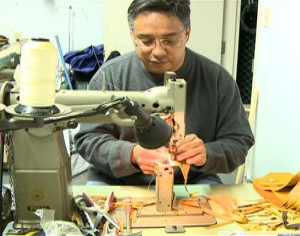Moccasin making passed down through generations
By Trish Allison

Photo by Trish Allison. Curtis Maracle stitches together part of a pair of moccasins in his shop on the Tyendinaga Mohawk Territory.
Down a long stretch of country highway, up and around a couple of bends on a back road, sits a man working to keep tradition alive, one stitch at a time.
Curtis Maracle is a Tyendinaga resident and an artist in the craft of moccasin making.
“It certainly is a way to, to remind them of who they are, who we are,” said Maracle.
“Whether they learn how to do the entire moccasin, or they learn how to do the sewing and or the beading.”
In the face of a rising fashion trend and the over-commercialization of a Native American tradition, Maracle is one of a few who still hand-makes moccasins in the area.
“I don’t want to get large like that, I don’t want to be mass producing,” he said.
“I want to be more authentic.”
He originally learned the art from his mother in the mid nineties, who in turn had been taught by his brother in the early eighties.
“She had been doing it from that time, up until about 1995 -96,” he said.
“When she asked her kids who wanted to help out, or who wanted to take this over, I jumped aboard.”
But it wasn’t until last Christmas that he started to seriously make them.
“I did it for a couple years with her, and the I sort of ventured off to do other things,” said Maracle.
After taking time to study the Mohawk language, take courses at Trent University and continuing with other ventures, Maracle decided to get back to his roots.
“When my mother was slowing down in this business and she kind of stopped for a year or two and people were sort of running around wondering where they were going to buy their moccasins,” he said.
“When they realized I was taking the art back up, they were all actually very happy I picked it up again.”
Maracle works out of a little room in what used to be a shoe manufacturing company many years ago.
“If I have everything here, the leather, the lining material, and it’s all sort of set and ready to go, it doesn’t take long to make a pair of moccasins,” said Maracle.
He can average a pair an hour and roughly 160 pairs a month, earning him a modest living.
“My goal is to not work for anybody else again,” he said.
But it hasn’t been completely easy going for the moccasin maker. In May, Maracle applied to a program through what used to be called Aboriginal Business Canada to get funding to help with his business. Since then he was deferred until this month.
“I was assured that I was going to have an answer this past Monday, but I still haven’t heard from them,” said Maracle.
On top of that, he faces the challenge of competing with mass markets and the quick turn-around of moccasins for the supply and demand of consumers across the world.
When asked if he thought this market would affect him, he said price-wise he was unsure.
“When you talk about mass production, it varies with the type of leather they use, it could be deer hide, could be cow hide,” he said.
“That really adjusts the price for a pair of moccasins.”
Ironically, other moccasin makers in the community, see Maracle as a problem.
“To them I’m a mass producer, but I’m not making tens of thousands of moccasins.”
But the light-hearted craftsman doesn’t let the competition get to him. He just focuses on his work and his five-year plan that includes being able to buy his supplies in bulk.
In the future, he hopes to pass the art down to his daughter – a great way to keep this disappearing tradition alive and well.
In the meantime, Maracle works to produce and produces to sell.
“When I go to the market in Belleville, I joke around ‘cause I say I’m going to have to get a shirt silk screen that says ‘yes I make these moccasins’ because people are surprised that I’m making these moccasins,” he said with a chuckle.
 Print This Post
Print This Post






